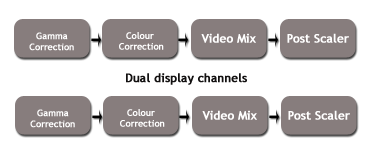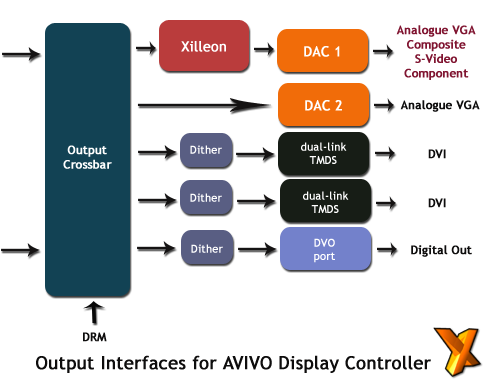Display
Display

Mmmmm, dual dual-link DVI. Mmmmm, 10-bit from start to finish. Let me explain.
10-bit? 10-bit!
Visual fidelity, where you want to reproduce video and graphics on your display device, can never be good enough. You might be impressed by framerate most of all, but those frames better look good too I hope? Right? Riiiight. A little discourse on displays then before I begin.I'm tapping this article out to you on a Philips 200P4SS. I love this display, and so would you. The Super-IPS LCD panel is a true 8-bit per colour component RGB display with a 16ms response time. A 20.1 inch diagonal and DVI input makes me smile every time I come up to my office and sit down to write this nonsense.
The reality is that most LCD panels out there, especially those that are smaller and less 'professional' (lest I show off a bit more), are pretty pants. While a 2D image can appear to look good on anything with the pixels in the right place and good basic image adjustment, the reality is a bit different and 3D is a whole different kettle of fish. Most gamer's displays out there today with low pixel refresh will be 6-bit in terms of colour depth (18-bit total, RGB) for a total of 262,144 colours. Urgh. By comparison, my 8-bit panel (24-bit total RGB) is a much more pleasing 16,777,216 possible colours per pixel.
At the very high end you can also get 10-bit (30-bit RGB) displays. Mostly used for photographic work and applications where colour reproduction is king, they sport just shy of 1.1 billion colours or 64 times that of my excellent 8-bit panel.
With 10-bit destined to drop into the prosumer area (where my Philips sat on launch and the almost identical Dell 2001FP still does, but at prices you can't help but love) given time and the focus on pixel refresh hopefully going away for the gamer, ATI feel it prudent to get in on 10 bits of colour depth per component early, with Avivo.
To best support that, their diagrams show they support 10bpc colour from the start of the display controller all the way out to your display, even if it's not 10-bit native. I'll explain that in a bit. In the meantime, everything from final pixels in the framebuffer to crapping it out of the DAC or TMDS to your display (preferably digital) can be 10bpc. When outputting to a digital display that's not 10bpc-native, it'll dither in a couple of ways. Analogue output remains in 10-bit colour resolution at transmission over the cable to the display.
Here's the basic display engine in stages.

Avivo-capable display controllers have a pair of output engines infact. Gamma and colour correction (including colour space converting from RGB to component if outputting to a component colour display) start things off before the hardware mixes in any video surfaces that might be hanging around for display, that have been processed earlier in the pipeline explained over the last few stages. Lastly, the post-scaler is what fits the video to the display device you're outputting to. Think Dscaler, but in hardware. Avivo has supposedly been designed from the ground up to support HD resolutions, and the scaler in hardware is designed to fit the requirement that Avivo devices be top class HD citizens.
The scaler can be configured via querying the display hardware's timings to find out exactly the space the output has to fit into. Video, if fullscreen, isn't subject to the pre-scaler in the Process stage but the post-scaler in this Display stage. Output video once passed through the first section of the Display stage hits an output crossbar where the Avivo hardware decides where it's going.
The pipeline is processed fully in 10bpc colour space, as mentioned before. Now the colour space dithering happens as part of a post-crossbar process.
Output controllers

The first thing you'll notice is the first generation Avivo controller support for digital rights management. As a good video citizen, Avivo's output hardware must apply HDCP (High-bandwidth Digital Copy Protection), CGMS-A (Copy Generation Management System for Analog) which protects the analog broadcasts that might be fed into the Avivo controller from a Theater 550 PRO, Macrovision (multiple content protection schemes for analog and digital video output) or others if requested, before output over a cable to a display. HDCP is required for HD video (and audio over HDMI) display on HD-able displays, lest the Avivo engine downscale to 480p (or something else, it's unconfirmed as yet but likely 480p).
A HDCP license requires that you stick to those rules. With Avivo suitable for a range of HD display tasks, including the DRM was a requirement for ATI to legally build the technology. The FCC governs HDCP's usage in the United States and EICTA followed suit in Europe earlier this year. Anything 'HD Ready' in Europe must support HDCP, which includes Avivo-able products (where applicable). DRM for displays is a massive article on its own, so I'll leave it there for now.
Output to an analogue TV and the video will pass through an integrated Xilleon TV encoder which exists on the die with R5-series hardware. Xilleon products power the majority of the world's HD televisions and the decision was made to use the same consumer display-friendly technology block in first generation Avivo hardware. The encoder is able to 'talk' to a vast majority of displays, find out what resolution and aspect ratio they're in and deal with the output from the display crossbar accordingly. Output options from the Xilleon are AIB dependant, per SKU.
There's a straight output from the crossbar into the 10bpc DAC for straight VGA output. Hopefully the less of those we see the better.
Then comes digital output via a pair of dual-link digital TMDS transmitters, after passing through the dithering silicon if needed. If outputting to a 10bpc native display, that silicon acts as a passthrough. Again, there's a pair of dual-link DVI TMDS transmitters on every R5-series graphics chip. I'll let you ponder the obvious caveat quietly while I get to the last bits. While I've not labeled them as such, the transmitters support the video component of HDMI as expected.
Finally, a fifth output is left hanging for connection to whatever the AIB chooses. I'll talk dithering and likely display options on various SKUs on a new page, follow me.









